Review of Nokia 5610 Xpress Music – no time without music
Nokia 5610 Xpress Music is very interesting new product proving determined Nokia’s resolution to take a market niche of music phones, which used to be dominated by Sony Ericsson.Table of contents:
- Design
- Sales package
- Review content
- Multimedia
- Player
- Sound quality
- Applications
- Camera
- Phone quality
- Conclusion
The whole story started in 2004, when the SE marketing department equipped the new bestselling device with the hardware platform featuring the best sound quality among the rivals.
The different researches proved that the consumers of multifunctional communicators and smartphones were ready to subsidize their players with a device combining different functions in order to save time. Everything indicated that the market were ready to bring about a pioneering music phone. Of course they failed to create the perfect music phone; however, youth design, good sales package with a $20 headset (the latter was very uncommon that time) and Walkman brand, passed to the parent company Sony after tough time, made their best. The music brand used when hyping the flagship model W900i brought about the company the highest sales among the phones cost more than $200. Neither Nokia nor Motorola had anything to oppose this success and gave Sony Ericsson the large segment of consumers. As we mentioned, the main reason of success was the well-known brand name and good audio-elements. The defects were smoothed by the headphones from the sales package providing a comfort sound without make-yourself improvements. Nokia made mistake, when planned to develop this line of phones only in 2007 and the rivalry company shuffled the company’s strategy.
In 2005 the Finish company announced very interesting solution based on the ideas of the main platform supplier – Texas Instruments. The phone was intended to rival with the companies installing 1’’ hard disks to provide devices with a larger memory. The handset was advertised as the flagship model of the N-Series devices. It hasn’t anything common with a music phone, except several gigabytes of the internal memory. Of course, you recognize the N91 in it. Together with the N91 they decided not to delay the new handset with a Twisted form factor featuring the music appliance. It was Nokia 3250 aimed at the music addicts. The company even had to deliberately delay the other Symbian 9.1-based smartphones. The device was launched to rival Sony Ericsson W810i; but some hardware limits, as well as old audio platform brought bad luck. To make the things worse, American giant Motorola sold the ROKR E2 only in the Asian countries.
Hoping to improve the situation, Nokia launched a new musical brand Xpress Music including both the cheap slider phones 5200/5300 and remakes of the music solutions 3250 and N91 with a better design. The new brand hasn’t seen great success. However the vendor made every efforts to improve the main defects of the 3250 - the weak sound hardware and the corresponding drivers. Fortunately, the N91 became more and more talked over among the users of the rivalry devices. Nokia still could boast about the device comparable with some players, unlike Sony Ericsson kept within Philips’ limits, which considered sound quality of Nexpieria 128 enough to the music phones.
We don’t know how the things would have been, if Nokia hadn’t sacrificed the part of the accessories market, in order to provide the other communicators with the common headphones jack and classic miniUSB. These improvements implemented in the N91 made a stir on the market in 2007. Since then the company brought about handsets equipped with these jacks in combination with long-awaited digital-to-analog converter doubled as the amplifier. The latter was implemented very wisely to single out the 5700 among the other smartphones. The individual digital-to-analog converter became one of the cornerstones in the PR.
It is noticeable, that during that year the brand Xpress Music remained just an addition to the name similar to Sony Ericsson Walkman Series. But everything changed when in 2007 the company went on the market of personal audio. The company used the experience of Apple, notably the idea of the music on-line shop. Eventually they introduced two devices featuring both the Jack connector and 3.5mm headphones jack. They planned to use the worn solutions different from Xpress Music devices with a wide price range and dissimilar design. That’s way we have the 5310 XM with a moderate price tag competing with the W660i. The review model we have to-day, Nokia 5610 XM, is a powerful rival of the W910i. The proper epigraph to our review may be the following - “haste makes waste”. But let’s move on from the comparison, into the phone itself, which is worth to be discussed thoroughly.
Design


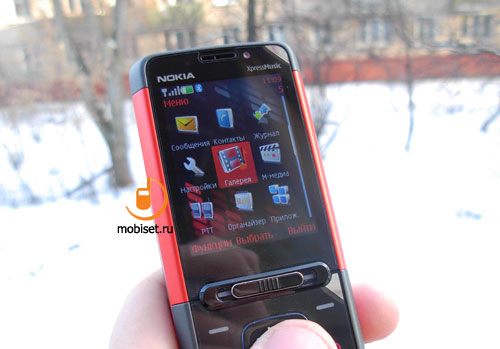
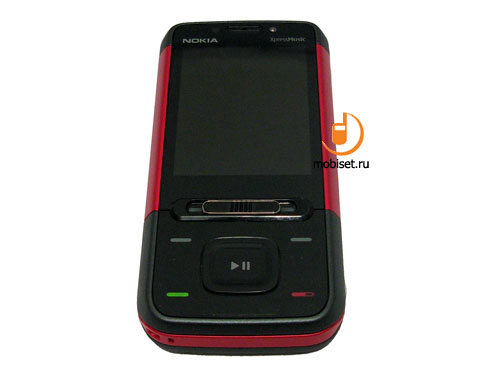
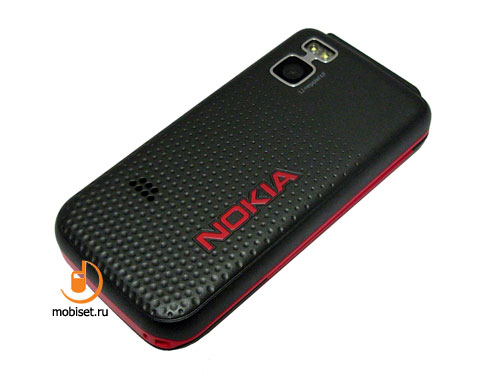
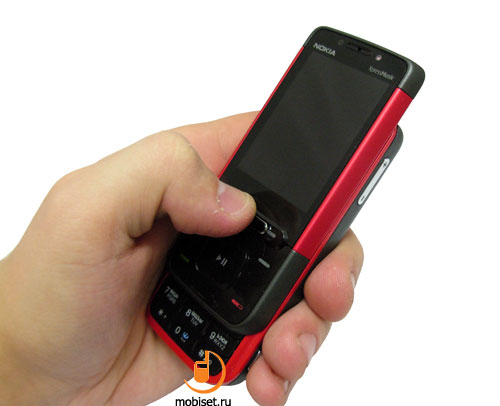
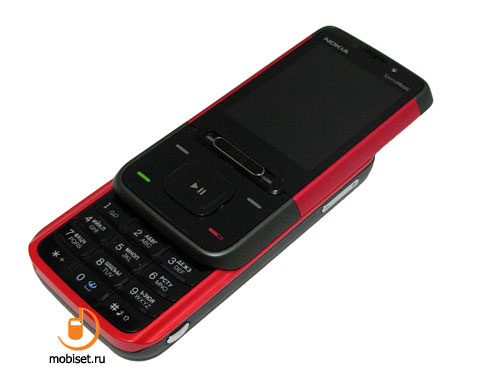
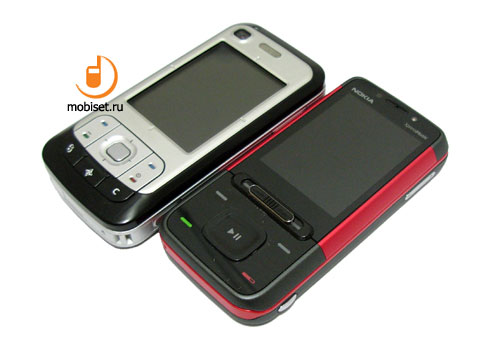
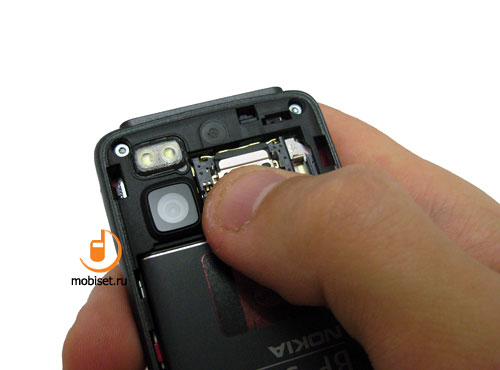
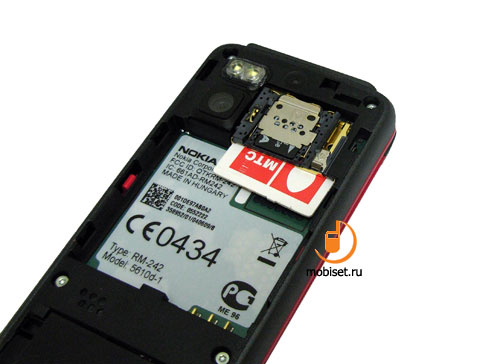
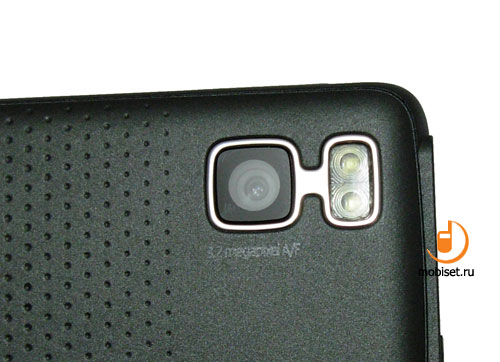
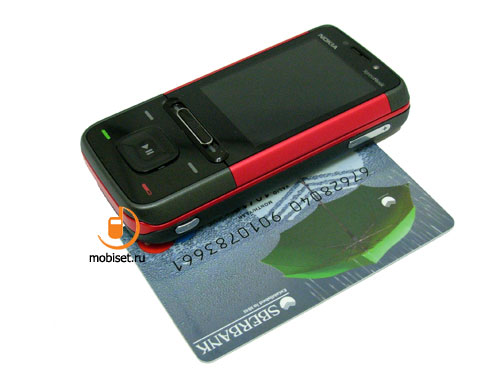
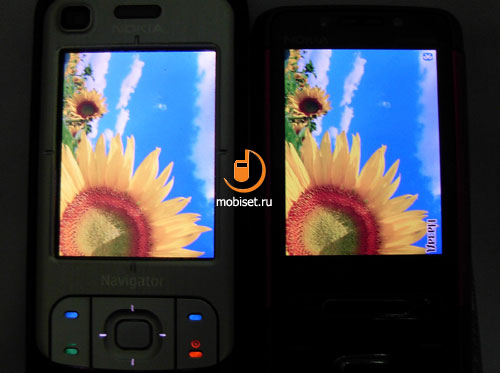
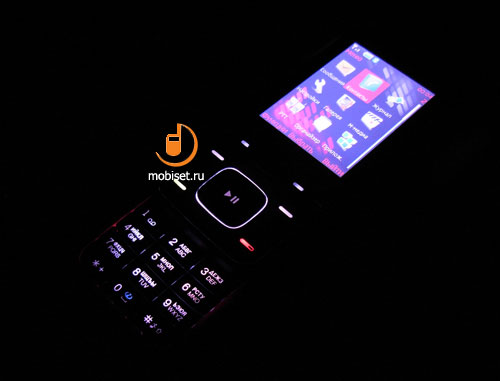
The phone has a slide form factor; measured 98.5x48.1x17.2mm, weighted 112g the device turns to be very pocket friendly. The casing is made of black plastic painted in dark-grey, which makes it give comfort tactile feedback resembling velvet. The colour of plastic remains unchangeable regardless of casing colour. The latter can be either blue or red, which we have today to check out.
The solutions differ only in colour of bands, which are surprisingly made of aluminium easily became cool when the frost. We’d like to note the built quality. The phone has some squeaks and creaks, but they are noticeable when it unfolded and caused by the combination of different materials used in the bottom part of the casing around the keypad.

The front fascia is made of the gloss plastic initially covered with the protecting films with silver ends. In the middle of the top part you see the oval hole of the loudspeaker. In spite of the tiny size, it provided good audibility even during the first call. To the right of the loudspeaker you find the tiny CIF-camera for video calling and portrait shot if you are very keen on it. The left of the loudspeaker the phone features the light sensor, which doesn’t optimize the display and keypad backlit; it used only to switch on the flashlight when shooting.
Beneath you see the 2.2 inch TFT screen with QVGA resolution. With a screen started 1sm below the top edge, the phone looks rather good. The second thing, that you are sure to notice is very bright screen, which defeats other 2.2inch screens installed in the 7500, the 6500 C, the 5310 EM.

In order to compare our guest we chose the 6110. The visual anger is perfect due to the good brightness. You have 140 degrees in all directions, but then the picture is covered with a white sheet. The screen is unlikely to have problems in the sunlight; though we can’t guarantee the perfect visibility.

Beneath the screen you find the large thumb rest to open/close the casing, which doubles as popping out slide key. The latter we’ve seen once again, but now let’s look at the big flat gloss Play/Pause key in the middle.

This big button is a five-way NaviKey framed by the two soft-keys above and send and end keys below. The latter doubles as a power key when the long pressing. Unlike the special power key, the phone doesn’t provide the list of profiles after the pressing. We don’t have any complaint about this keypad, except the gloss finish, which makes fingers slip, after the long work. The travel is about the average; the NaviKey has a muffled click, different from the other clearly sounded keys.
As we mentioned, to open the device the vendor provides the thumb rest; however, we found it handier to open it when pushing the moving part at the bottom part. Spring mechanism is quick, half of the way you open yourself, the other part is opened with the help of the mechanism. Being the well-balanced, the parts of the phone are saved from the falling down when you open it. The handiest way to close the device is to put the finger above the rest, consequently leaving greasy finger print on the screen. So we’d like to recommend you to arm yourself with patient and cleaning tissue, which comes in handy while working with this mobile phone. After opening the handset, we see large numerical keypad matching the one in the 6110 Navigator, except the bigger buttons. It is handy to work with during both ten seconds and several hours, as it has perfect ergonomics. The buttons are divided by the deep cuts, which easily help you to cope with the blind typing. It deserves the highest appraisal as well. The “4” and “7” keys located on the side frame the mike hole. This solution is very original, and makes anyone puzzle if you give him/her the task to find it. You are also enabled to speak with the closed phone, but the voice sounds noticeably damped.

The left edge can’t boast about any element.

The right edge houses the narrow volume rocker key, which unlike the same one in the 5310 has the worse ergonomics. The problem is that it doesn’t jet out, and the travel distance is only 1mm. Had it been two times wider, everything would have been OK. Only the distinctive click saves the day a little. About the bottom edge you find the dedicated 2-steps capture key with the focusing function.

To hold the phone is handier using two hands, while one-handed control makes you hold it on the left bottom corner with the forefinger crooked.

The bottom finger is equipped with the band hole. But the latter is very annoying, as when putting even the thinnest loops through it, you see only them but can’t pull out. The thick strong wrist bands to the camera are beyond the mentioning. In general, if you are not accustomed to this accessory, follow our advice and leave them apart.

The top end houses the whole set of jacks. The ends are occupied by the 2mm charger slot and 2.5 headphones jack.

The former is simple as a day, while the latter is rather troublesome. We plugged the headphones end very easily in the absolutely new device. Consequently it pulls out with the same easiness, which may cause some problems. In the centre of the top end the phone features microUSB slot to wire with PC, but not to charge.

The whole rear fascia doubles as the battery cover. It has dozens of peculiar dimples growing in size from top to bottom. Some of them turn to be the holes of the polyphonic loudspeaker.

The left top corner features the camera consisting of two LEDs and 3.2megapixel autofocus camera. The casing doesn’t have Carl Zeiss logo, but still the optic’s quality is on the same level with the one in the 6500 Slide.

To remove the battery cover the vendor provided the handset with the special button located between the charger slot and MicroUSB slot. After the pressing the button, the top end of the cover raises a little. Then unfasten it near one of the ends and pull it to this side. Though to get the full impression you’d better look at the video clip.

After removing the cover we see the inner parts of the phone.

The first notable thing is Nokia Battery BP-5M 900mAh providing up to 3 days in the saving mode and up to 2 days with 3 hours in the playback plus 20 minutes of talks every day. It is a good result for a phone with a rather big display. The battery lasted 19 hours in the playback mode, but the utilized earcup headphones shortened this result up to 12 hours.

Above you find the microSDHC memory card slot. To install the latter you need to pull the latch down and insert the card. To the right of the slot you notice a slider button marked with an arrow sign.

After the pulling the slider in the pointed direction, you can take out the sim.

To put it back is very easy, just pull it in the pointed state into the cut. It isn’t anything peculiar, though we found it rather impressive. The other things are of not interesting at all. We can only mention the antenna located below and the popping out latches of the red aluminum band.
Sales package
Stepping aside from the usual way of describing the sales pack, we’d like to look closely at the most interesting accessories. First of all, you haven’t found any memory card in the sales pack and adaptors, as they have already inserted in the slots. The 1Gb memory card from the sales pack is sufficient to those, who haven’t tasted the 4Gb one, though the latter is rather affordable nowadays in all shops.
The second accessory worth to be mentioned is the headphones adapter. Its design utilized flavor of both IPod Shuffle 2G and toy construction set LEGO. The former brought about a clothespeg-like look, the latter – the jutting out transparent tag Nokia.


Unlike a control panel installed in the smartphones, our review model comes only with one control key in charge of voice dial and call receive/end. We tried to use the control panel of the 5700, but failed, as the keys don’t work. We’d like to say a couple of words about the headphones. They are the common earbuds resembling the well-known HS-42. We can’t say about the high-quality, but we have to check them during our test.
Review content
This time we made our mind to leave the common form of the review and introduced the most interesting features of the device. In general we have the common 5th edition S40-based handset running ARM9 CPU. That’s way the 5610 ships with the program system on board identical to the 7500 Prism. That’s way we passed away the previously described features, and concentrate on the multimedia.
Multimedia
The most noticeable control key of the phone is the slider cycling through the phone modes. Of course, the vendor can’t implement the set of interfaces in the S40, but the available Flash-based interface creates the smooth visual effects of the full-screen view in any menu item. The future may see very interesting solutions based on the same principle in Nokia or in other vendors. Now we can consider it a kind of analogue to TouchFLO.
Interface demonstration, avi, 19.3 MB >>>
So we have to do with the slider key, which can be pulled in the both directions, but it returns in the home position. When pulling it to the left, the current picture flows in the same direction followed the next mode. There are three modes available ranged in the invariable order: radio – phone idle mode – music player. Unlike the system utilized in the HTC device, the phone cycle through the windows quickly and smoothly. But there are some peculiarities. For example, when Java is switched on, the slider key closes it automatically, after pulling it. The device can’t perform several tasks simultaneously.
Let’s start from the radio.
The phone comes with the renewed FM radio supporting long-expected RDS, as well as the renewed design. Now the display calls up the horizontal scale of the frequency range from 87.5 till 108 MHz. The handset allows to search the stations automatically which can be saved in the list containing 30 cells. This search manipulation takes about 2 minutes, as the device scans the whole range.








The RDS differs from the one in Sony Ericsson devices. It is useless, as it doesn’t call up the names of the stations. In general, we have the classically implemented radio inherent in Nokia phones. But the signal receive level remains very good, but the manual tuning to within 0.05 MHz works very slowly.


Player
Unlike the other 5th Edition S40-based handsets, the 56100 has the player/radio themes implemented in the urban black style. All tracks can be sorted according to the same principle. But you are also enabled to remove the tracks by playlists, artist, album and genre. The information about a track is saved in the ID3 2.0 tags. Similar to the Walkman 2.0 interface, you can navigate through the library declining the navi key. The device has very handy feature – after switching off the phone or installing the memory card, the phone starts refreshing the player library.



The playback window comfortably displays the service line with current events and indicators of the signal receive level, as well as the battery charge level. Other features of the interface are similar to those in N73 ME, N91, 5700. Album Art program, which can be extracted either from the ID3 tag or a folder containing tracks, has different sizes depending on the theme. The latter also determines the background picture and the scrolling size. Among the drawbacks we can name the 5-point volume scale, though there are 10 points in fact. Compare them with 16 points on the volume scale in Sony Ericsson devices and 20 points in some S60-based Nokia’s smartphones (N91, N76, N81).

The volume settings don’t differ from the other models equipped with the 5th edition of S40. There are as follows: shuffle, repeat all songs, repeat current song, stereo widening. The latter is improved in comparison with the previous models. For example, now after activating the mode, the low frequencies don’t disappear.
Equalizer kept usual 5 scales; to each of them you can adjust one of 9 levels with the step 3 dB. The equalizer settings notably change the sound quality. For example, those keen on basses, may adjust the Bass scale and enjoy the powerful sound in the headphones Sony MD EX71.














Sound quality
This is one of the most disputable characteristic of both our review model and its cousin the 5310. To begin with, let’s look at the dedicated audio chip. We wonder, whether this expression can be referred to the digital sound consisting of the code algorithm. We think that this term “audio chip” is incorrect, as all equalizer settings and other effects are performed by the OMAP ARM9 processor. The first reason is energy consumption, the second one – all mp3 players utilize the same solutions with one chipset. They have the main computing power of 40-60 MHz processors directed at the digital audio files processing. As to the mobile phones, most of them utilize the 220MHz processors that are enough to be busy with the audio files processing. And here we face the problem inherent in modern Sony Ericsson devices. The quality of the digital sound depends to a large extend on the codecs and algorithms of the mp3-files decompression. The new Xpress Music devices is equipped with renewed set of drivers and codecs explaining why the 5310, the 5610 and the 7500 have the same sound quality.
This dedicated audio chip is common single- body digital-to-analog converter combined with an intensifier in the headphone’s jack named Texas Instruments TRA4411YZHR. This solution is disputable, as it provides mediocre sound decompression, while the closely located amplifiers erase the stereo stream making the sound flat. To put it simple, without listening at least one track, the sound is likely to be shallow and noisy.
Let’s go further. With several headphones we try to evaluate the sound quality. The tested tracks include different styles of music. Bitrate amounts to 320Kb/s in mp3 format, and 1411 Kb/s in Wav. The first thing you notice is high volume comparable with the 3250 with old firmware 3.21 and so on, as well as the low level of noises. The latter surprises, as the most players except Cowon D2 and IPod G5 have very noisy sound at the high volume. The second feature inherent in high quality is that the maximum volume keeps low frequencies. To our surprise the phone easily copes with Dimmu Burgir, Fear Factory, Children of Bodom, Rob Zombie. Tracks featuring the high frequency are better to have these frequencies decreased with the help of two rights scales of equalizer. Those keen on electronic music find the possibility to beef bass up very cool. Fans of hitting subwoofer will be delighted by the raising left bass scale of equalizer, as well as other minimized scales. In this case the hitting of the 5610 leaves Mega Bass far behind.
To sum everything up, we can say the following: the 5610 is one of the best solutions on the market providing good sound in common tracks, when using another headphones priced $25-60. The more expensive headphones may emphasize the weak dynamics, low dynamic range of the digital-to-analog converter, as well as sharp high frequency.
But now let’s put aside the headphones and with a help of the liner cable with a ground ant test the device by the RMAA program. We’d like to remember, that when testing, we use the weak sound card Creative SB Audigy with a 97dB noise level.
Summary
| Frequency response (from 40 Hz to 15 kHz), dB: | +0.14, -0.96 | Average |
| Noise level, dB (A): | -90.2 | Very good |
| Dynamic range, dB (A): | 89.2 | Good |
| THD, %: | 3.535 | Very bad |
| IMD, %: | 1.376 | Bad |
| Stereo crosstalk, dB: | -70.1 | Good |
| IMD at 10 kHz, %: | 0.717 | Bad |
General performance: Average
Frequency response

| Frequency range | Response |
| Îò 20 Ãö äî 20 êÃö, äÁ | -5.98, +0.14 |
| Îò 40 Ãö äî 15 êÃö, äÁ | -0.96, +0.14 |
Noise level

| Parameter | Left | Right |
| RMS power, dB: | -86.1 | -86.4 |
| RMS power (A-weighted), dB: | -90.1 | -90.2 |
| Peak level, dB FS: | -72.9 | -73.3 |
| DC offset, %: | -0.01 | -0.01 |
Dynamic range

| Parameter | Left | Right |
| Dynamic range, dB: | +85.8 | +86.1 |
| Dynamic range (A-weighted), dB: | +89.2 | +89.3 |
| DC offset, %: | -0.01 | -0.01 |
TND + Noise (at -3 dB FS)

| Parameter | Left | Right |
| THD, %: | 3.5349 | 3.5378 |
| THD + Noise, %: | 3.5498 | 3.5526 |
| THD + Noise (A-weighted), %: | 4.5035 | 4.5070 |
IMD

| Parameter | Left | Right |
| IMD + Noise, %: | 1.3763 | 1.3808 |
| TND + Noise (A-weighted), %: | 1.2355 | 1.2379 |
Stereo crosstalk

| Parameter | L <- R | L -> R |
| Crosstalk at 100 Hz, dB: | -69 | -5 |
| Crosstalk at 1 kHz, dB: | -69 | -5 |
| Crosstalk at 10 kHz, dB: | -69 | -6 |
IMD (swept tone)

| Parameter | Left | Right |
| IMD + Noise at 5 kGz, %: | 1.4602 | 1.4635 |
| IMD + Noise at 10 kGz, %: | 0.5186 | 0.5590 |
| IMD + Noise at 15 kGz, %: | 0.1716 | 0.1716 |
Sony Ericsson W610i
Nokia 5610
RightMark Audio Analyzer test
Testing chain: External loopback (line-out - line-in)
Sampling mode: 16-bit, 44 kHz
Summary
| Test | Sony Ericsson W610i | Nokia 5610 |
| Frequency response (from 40 Hz to 15 kHz), dB: | +0.17, -0.52 | +0.14, -0.96 |
| Noise level, dB (A): | -83.4 | -90.2 |
| Dynamic range, dB (A): | 85.0 | 89.2 |
| THD, %: | 0.024 | 3.535 |
| IMD, %: | 1.219 | 1.376 |
| Stereo crosstalk, dB: | -70.8 | -70.1 |
Frequency response

Noise level

Dynamic range

THD + Noise (at -3 dB FS)

IMD

Stereo crosstalk

The results prove almost perfect work of the amplifier and perfect one of renewed codecs, but unfortunately, the digital-to-analog converter leaves much to be desired. In general, in comparison with Sony Ericsson devices, we can pass an opinion, that Nokia’s device excels its rivals. If you are not aware of the specifications like harmonic, dynamic, distortion, energy and so on describing the D to A converter capacity, you can without hesitates buy Nokia 5610 with earcanal headphones JBG Reference 220, Sennheiser CX300, AKG 26p etc. it is interesting, that you can distinguish the difference between the 5610 and the N91 only in the quit places, for example, at home. But there you may prefer to use the music centre.
Applications
The phone ships with a set of different pre-installed Java applications on board.
Download! Provides you with a paid Nokia content. There is nothing special.





Converter features numerous categories.





World Clock lacks the active world map and snows the current time in four chosen cities.


Search is common app for web search through Yahoo and Yandex.


Installer (WidSets) is an interesting application presenting a RSS newsfeed including BBC and Euro Sport.


Sensor resembles the standard application inherent only in several series of Nokia phones, as you can’t find it in both 6500 devices, but it is available in the 7500, 7900. In principle, the aim of the program is to create a social network. You feel a form stating your interest, after that the phone starts looking for the phones with this app launched via Bluetooth channel. The search is based on the information from the forms. The idea is the same, when people get acquainted in the crowded places by means of sending pictures. The app is interesting, but as you can’t minimize the active midlet , it makes you annoying.









Yahoo!Go is a standard service search provider Yahoo.




Games
The set of the onboard games corresponds the price of the device. There is City Bloxx, making you press the button when a block falls. The more precise you are, the evener and better your house is. The house makes a part of the town. To my opinion the game is interesting and helps you to while away your free time.





Snake 3 – performed in the 3D graphic. But it can’t be compared with the one installed in the smartphones. It is rather unhandy and may attract only the fans of this game.




Rally 3D. For the first time we see this game in 2004 in the S60-based smartphones running Symbian 6.1. Formerly, the version of this game, namely SIS, was in the 3230. But for already year and a half it has been available in the Java-format. Fortunately, the change of the format didn’t affect graphics; the pictures don’t glitch. All in all, we have the same well-done rally with a ordinary and simple physics. The game is interesting, but after long time it may make you bored.



Music Guess is a music quiz. To play the game is simple: open a folder with tracks and then try to guess the songs. You have five answers to choose the right one among. Each track lasts 10 seconds; but after each two seconds, one of the false answers disappears as well as one point. The highest score for a question is 5 points. Then you face the second round, where you have to remember the location of windows with tracks, and choose the one corresponding to the played back song. The game is captivating and may entertain your friends and you, for example, if you have nothing else to do.








Jbenchmark1: 1745
Text: 403
2d shapes: 415
3d shapes: 313
Fill rate: 189
Animation: 425
Jbenchmark 2: 304
Image manipulation: 251
Text: 371
Sprites: 404
3d transform: 381
User interface: 181
Jbenchmark 3d
Jbenchmark 3d hq: 128
Jbenchmark 3d lq: 253
Triangles pear second: 32046
Ktexels pear second: 1324
Jbenchmark hd
Smooth triangles: 62842
textured triangles: 51912
Fill rate: 1536ktexels
Gaming: 110(3,7 frames per second)
Camera

The 6500 Slide handed down our review model the 3.2 megapixel autofocus camera with dual LED flash working both when focusing and shooting. To make the camera active, you need to enter the multimedia menu item or press firmly the release button in the idle mode. The camera needs 2-3 seconds to be ready to work; this time is one of quickest among the cellular phones. Among the drawbacks we can name the lack of the protecting cover, the coating plastic sinks only half the millimeter. As this solution is widely-spread among the other vendor, we have to wait for the phone featuring the mineral glass covering the camera lens, instead of the plastic, which is inherent in Sony Ericsson K850i and our guest Nokia 5610.


With the camera mode active, the whole screen acts as a viewfinder framed with signs to the soft-keys and service icons. The viewfinder works very quickly with a frequency 15-20frames per second without glitches and jerks. Of course, things turn to the worse, when you switch on the night mode increasing the exposure and decreasing the ISO. The fact, that you can’t adjust the ISO manually, is shortcoming. But if you survey all cheap cameras, you find Nikon Coolpix series L devices without the manual adjusting this setting. Let’s go further. When shooting, the screen calls up the icons of resolution, exposure, memory type, Bluetooth as well as photo/video modes. To switch to video mode and vice versa, you decline horizontally the navi key, whereas digital zooming when shooting video clips is activated with the vertical declines.
The other settings include:
- Portrait mode
- Brightness
- Flash can be either automatic, or switched on or off.
- Self-timer can be 3, 5, 10 seconds
- Sequential shoots consisting of 3 stills. Each of them is done within 15 seconds, including saving.
- Colour effects (normal, greyscale, sepia, negative)
- White balance (auto, daylight, tungsten, fluorescent, horizon)






The settings also adjust the JPEG quality – that is image quality (50, 75, 98%) and image size (1536õ2048, 1200õ1600, 960õ1280, 480õ640, 240õ320, 120õ160). You are also enabled to adjust image/clip preview time (3, 6, 10 seconds, end manually, no preview) and camera sounds.









As usual you can judge the image quality yourself.
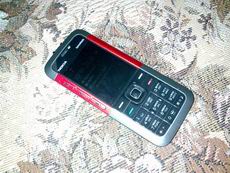











When shooting clips, you are allowed to use the colour effects and white balance, but you can’t utilize focusing, as the optics is adjusted automatically to the landscape mode from half of metre and further. We like, that the device records video clips with a frequency 15 frames per second, with two kinds of resolution: 352x288 and even 640x480.




Video sample 1, 3gp, 2.5 MB >>>
Video sample 2, 3gp, 5.3 MB >>>
Of course, as the handset can’t boast about the coprocessor to process the megabites video streams, the clips quality is worse than the one in the smartphones N93i, N95, N82. But in general, considering the rival models of other vendors, here we have one of the best video shootings. The clips can be viewed either in the phone or PC.
Phone quality
The connection quality is rather good comparable with other handsets of the company. The loudspeaker is loud enough to be used almost everywhere, except in a platform in metro, when the train is coming. In this case the headset is the only to help. The speech rendering got a mediocre appraisal – neither bad, nor good. The polyphonic loudspeaker can be heard only in a quiet street; whereas the vibration can be felt everywhere. So the device is equipped with a mediocre loudspeaker and a bit better vibration.
Conclusion
The Nokia music slider turns to be one of the most interesting devices in this price segment. Unlike its steel twin 6500 Slide, our guest is directly aimed at the young people keen on music. Moreover the device kept the other functionality including 3G connection and 3.2 megapixel autofocus camera. As to the drawbacks, they are as follows: the moving front fascia fidgets when the device is opened; the front panel attracts lots of greasy fingerprints; the phone used to reload when listening to the music. The latter is caused by the mode switching slider, which can be a predecessor of the key switching among the active apps in future devices. The multimedia is also on the high level. Thanks to the convenient interface, the vendor managed to create interesting and handy player windows; the sound quality, as well as common headphones’ jack allow to set the 5610 on the one level with the SE Walkman-branded cousins.
This phone may attract all young people using mp3-players with common headphones, and having enough money to spend it on the 5610, as the latter costs about $600, though the price is likely to decrease to the claimed 360EUR.
Among the rivals we can first of all emphasize the model, which Nokia 5610 is to compete with, namely Sony Ericsson W910i. The Finnish device is notable for the better built quality, autofocus camera, good player ergonomics, as well as the sound quality. We omit the more reliable headphones jack; though the W910i can boast about the better display and richer sales package. The second possible rival at first stage is, strange as it may seem, the N81-3, as it features Wi-Fi and S60 Symbian 9.2.
An annoying glitch in 4.20 firmware turned the music playback duration test into not very catching game: after every 30-40 minutes of playback, the phones reloads, hereupon our test is interrupted. Though we tried to make use of another adapter, the problem remained.
SAR value for Nokia 5610XM is 1.14 W/Kg that is a bit larger to the average result of the company.
© Written by Tikhonov Valeriy, Mobiset.ru
Translated by Arina Urban.
Published — 15 January 2008.